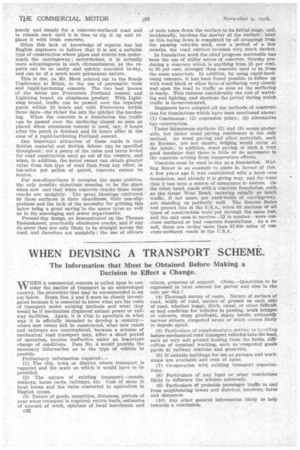WHEN DEVISING A TRANSPORT SCHEME.
Page 124

If you've noticed an error in this article please click here to report it so we can fix it.
The Information that Must be Obtained Before Making a Decision to Effect a Change.
'THEN a commercial concern is called upon to con sider the matter of transport in an undeveloped country, the procedure that may be recommended is set out below. Items Nos. 2 and 3 must be closely investigated because it is essential to know what are the costs of transport under existing methods and what they would be if mechanism displaced animal power or railway facilities. Again, it is vital to ascertain in what way it is officially intended to develop a country— where new towns will be constructed, what new roads and railways are contemplated, because a scheme of mechanical road transport may, after a short period of operation, become ineffective under an important change of conditions. Item No. 4 would provide the necessary information as to the type of vehicle to provide.
Preliminary information required :— (1) The city, town or district where transport is required and the scale on which it would have to be provided.
(2) The nature of existing transport—camels, donkeys, horse carts, railways, etc. Cost of same in local terms and the rates converted to equivalent, in English terms.
(3) Nature of goods, quantities, distances, periods of year when transport is required, return loads, estimates of amount of work, opinions of local merchants and 042 others, promises of support. (Note.—Quantities to be expressed in total amount for period and also in the rate per day.)
(4) Thorough survey of route. Nature of surface of road, width of road, nature of ground on each side of road, whether boggy, ditch, canal, or other difficult or bad condition for vehicles in passing, weak bridges or culverts, steep gradients, sharp bends, extreme's*, narrow streets, congested areas or other causes likely to impede speed.
(5) Particulars of supplementary service in hendling before mechanical road transport vehicles take the load, such as very soft ground leading from the fields, difficulties of terminal working, such as 'congested goods yards at railway stations and ginneries.
(0) If suitable buildings for use as garages and workshops are available and rent of same.
(7) Co-operation with existing transport organizations.
(8) Particulars of any legal or other restrictions likely to influence the scheme adversely.
(9) Particulars of probable passenger traffic to and from neighbouring towns and districts, numbers, fares and distances.
(10) Any other general information likely to help towards a conclusion.












































































































































































































